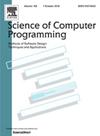Verifying chip designs at RTL level
IF 1.4
4区 计算机科学
Q3 COMPUTER SCIENCE, SOFTWARE ENGINEERING
引用次数: 0
Abstract
As chip designs become increasingly complex, the potential for errors and defects in circuits inevitably rises, posing significant challenges to chip security and reliability. This study investigates the use of the SAT-based bounded model checking (BMC) for Propositional Projection Temporal Logic (PPTL) to verify Verilog chip designs at the register transfer level (RTL). To this end, we propose an algorithm to implement automated extraction of state transfer relations from AIGER netlist and construction of Kripke structure. Additionally, we employ PPTL with the full regular expressiveness to describe the circuit properties to be verified, especially the periodic repetitive properties. This is not possible with Linear Temporal Logic (LTL) and Computational Tree Logic (CTL). By combining the PPTL properties with finite system paths and transforming them into conjunctive normal forms (CNFs), we utilize an SAT solver for verification. Experimental results demonstrate that our verification tool, SAT-BMC4PPTL, achieves higher verification efficiency and comprehensiveness.
在 RTL 层验证芯片设计
随着芯片设计变得越来越复杂,电路中出现错误和缺陷的可能性不可避免地增加,这给芯片的安全性和可靠性带来了巨大挑战。本研究探讨了基于 SAT 的命题投影时态逻辑 (PPTL) 有界模型检查 (BMC) 在寄存器传输层 (RTL) 验证 Verilog 芯片设计的应用。为此,我们提出了一种从 AIGER 网表中自动提取状态转移关系并构建 Kripke 结构的算法。此外,我们还采用了具有完整规则表达能力的 PPTL 来描述待验证的电路特性,尤其是周期性重复特性。这是线性时态逻辑(LTL)和计算树逻辑(CTL)无法做到的。通过将 PPTL 属性与有限系统路径相结合,并将其转换为共轭正则表达式 (CNF),我们利用 SAT 求解器进行了验证。实验结果表明,我们的验证工具 SAT-BMC4PPTL 实现了更高的验证效率和全面性。
本文章由计算机程序翻译,如有差异,请以英文原文为准。
求助全文
约1分钟内获得全文
求助全文
来源期刊

Science of Computer Programming
工程技术-计算机:软件工程
CiteScore
3.80
自引率
0.00%
发文量
76
审稿时长
67 days
期刊介绍:
Science of Computer Programming is dedicated to the distribution of research results in the areas of software systems development, use and maintenance, including the software aspects of hardware design.
The journal has a wide scope ranging from the many facets of methodological foundations to the details of technical issues andthe aspects of industrial practice.
The subjects of interest to SCP cover the entire spectrum of methods for the entire life cycle of software systems, including
• Requirements, specification, design, validation, verification, coding, testing, maintenance, metrics and renovation of software;
• Design, implementation and evaluation of programming languages;
• Programming environments, development tools, visualisation and animation;
• Management of the development process;
• Human factors in software, software for social interaction, software for social computing;
• Cyber physical systems, and software for the interaction between the physical and the machine;
• Software aspects of infrastructure services, system administration, and network management.
 求助内容:
求助内容: 应助结果提醒方式:
应助结果提醒方式:


